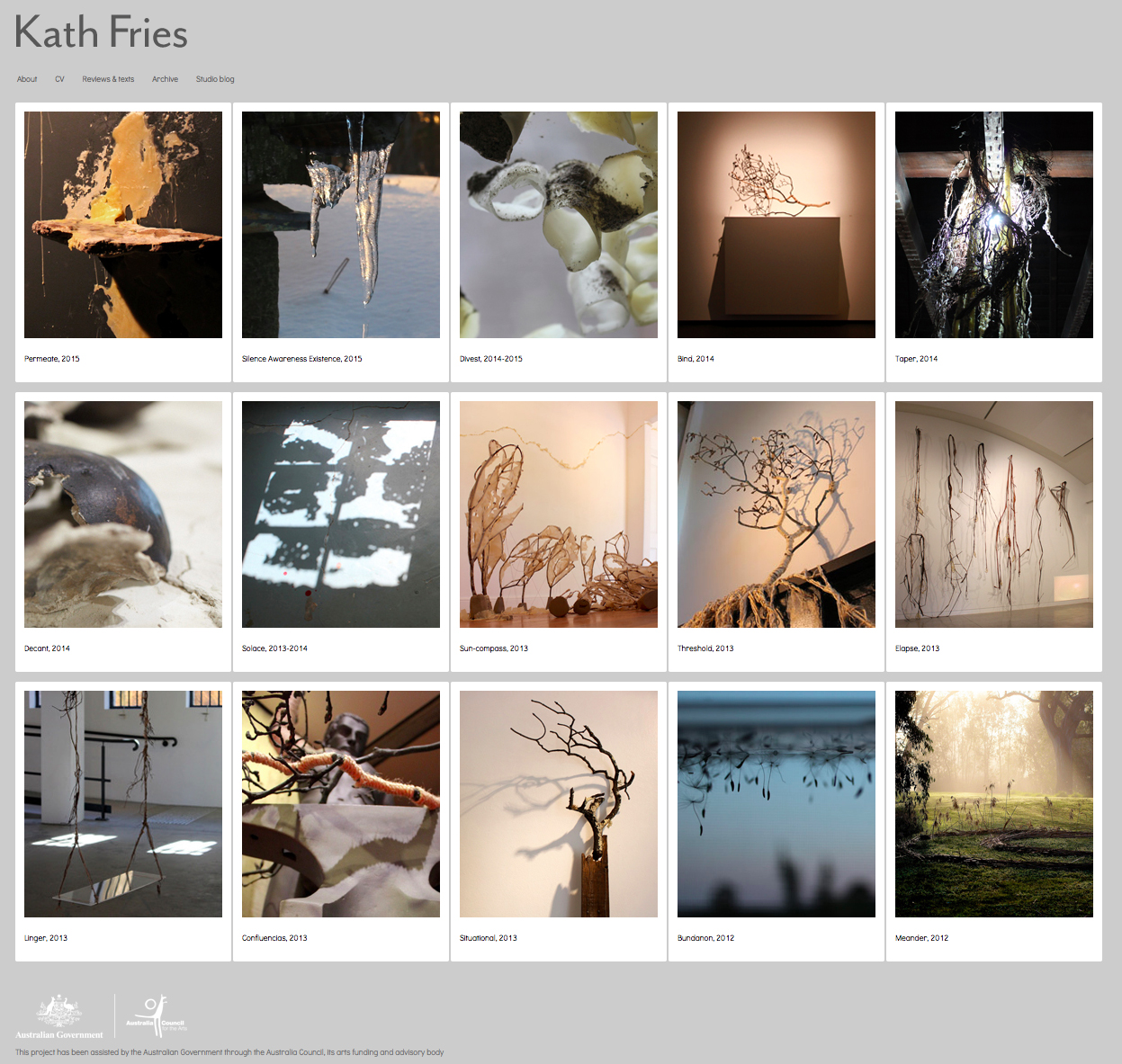 |
| Kath Fries, Threshold, 2013, cast bronze, rope, charcoal and steel doorway, 500x400x120cm |
Threshold is an intervention installation within the old steel levered doorways of the Incinerator Art Space, designed in the 1930s by Walter Burley Griffin. This doorway marks the original passageway through which ash from the incinerator passed into the outside world, forming the soil that nurtures today’s trees and parklands. In Threshold, the metal doors seemingly sprout metal branches and twigs. Bronze cast under intense heat using a ‘lost wax’ technique, these branches were burnt from the inside outwards, replacing the impermanent wood with bronze, rendering the branches’ temporary shapes into permanent forms.
 |
| Kath Fries, Threshold, 2013, cast bronze, rope, charcoal and steel doorway |
 |
| Kath Fries, Threshold, 2013, cast bronze, rope, charcoal and steel doorway |
Interconnecting, coiled and frayed ropes form root-like forms and link the metal branches to the steel doors. Trailing downwards the rope-roots encircle and claim mounds of charcoal on the gallery floor. As the draping rope-roots explore and entwine the heritage steel door structure a quiet, almost mediative, narrative evolves reflecting the passage of time and reminiscent of the giant strangling tree roots embracing the ancient temples at Angkor Wat, Cambodia. Threshold infers an inescapable metaphoric bind - humans are inextricably bound to nature, natural cycles and elemental forces beyond our control.
Threshold is being exhibited in Connexion Points - 2013 Willoughby Sculpture Prize until 22 September.
 |
| Kath Fries, Threshold, 2013, cast bronze, rope, charcoal and steel doorway |
Connexion Points - 2013 Willoughby Sculpture Prize
Incinerator Art Space
2 Small Street, Willoughby, NSW
31 August - 22 September 2013
Exhibiting artists include: Alan Rose, Andrew Lavery, Anthony Alston, Ariella Friend, Bethany J Fellows, Bianca Jane, Craig MacDonald, Diarmid Campbell, Douglas Cham, Elianna Apostolides, Ingrid Voorneveld Morley, Jane Gillings, Jenny Pollak, John Wright, Jonny Niesche, Julian Day, Karen Farrell and Amanda Hale, Kasane Low, Kate Scardifield, Kath Fries, Kelly-Ann Lees, Ken and Julia Yonetani, Laine Hogarty and Tamsin Salehian, Lauren Carroll Harris, Libby Tulip, Lisa Giles, Lucy Barker, Margarita Sampson, Marguerite Derricourt, Mariana Martin, Martin Rowney, Mellissa Thompson, Michelle Cawthorn, Miik Green, Niomi Sands, Pollyxenia Joannou, Rhonda Pryor, Richard Dunlop, Ro Murray, Sam Smith, Scott Chaseling, Stevie (Sarah) Fieldsend, Susie Hawkins, Sylvia Griffin, Tessa Zettel and Karl Khoe (Makeshift), Tracey Sarsfield, Vilma Bader, Wade Marynowski, Wona Bae and Yeehwan Yeoh.
 |
| Willoughby Sculpture Prize 2013 - Connexion Points |
Connexion Points: sites of exchange/types of exchange
Our living experience is dependent on connections. Throughout our lives we build a complex network of relationships with places, spaces and people. We engage in emotional, spiritual, physical, virtual, intellectual and cultural connections. Some are permanent and others are fleeting, some are deliberate while others are incidental. This confluence of daily exchanges, oppositions and developments form connection points to become a traceable web of interaction and influence that shapes our world.
All the while, the modes through which we relate and the types of connections we undertake are allowed to evolve rapidly via technology. New conduits for communication develop and the way we engage alters. Accelerated sharing of information has the potential to spark tensions and conflict resulting in new ideas and developments in economic, scientific, political, ecological, geographical, interpersonal, cultural, technological and artistic fields.
Methods for connecting may have increased but our motivations to form bonds remain the same. We wander through our natural environments to invigorate our physical and spiritual selves. We engage in business and social activity in our built and virtual landscapes but ultimately, we seek an understanding of place, self and culture to establish a sense of belonging. These sites of exchange and types of exchange are our connection points. The effects of our interchanges resound with each other and their traces are recorded in our environments to incessantly weave the fabric of our community.
Venita Poblocki (Curator, Willoughby Sculpture Prize 2013)
 |
| Interview about Threshold, North Shore Times, 30 August 2013, page 3 |






















%2BWhite%2C%2BBRANCH%2B3d.jpg)

















.jpg)













